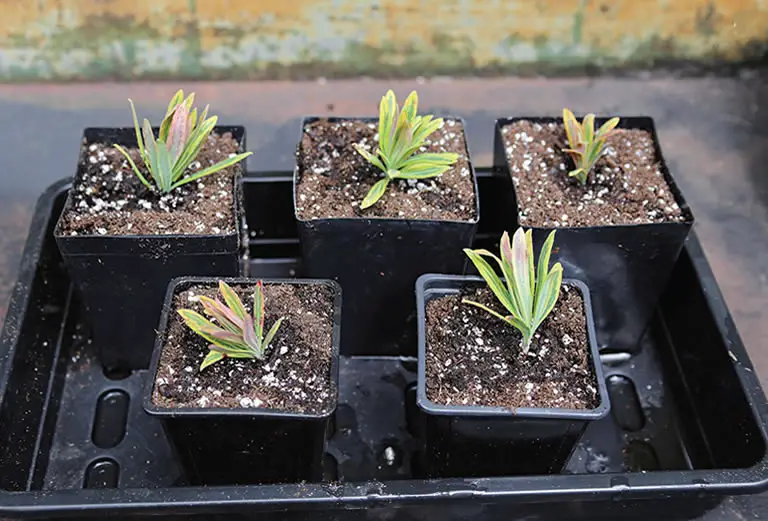With bold shapes, architectural lines, and incredible variety, euphorbias are plants you’ll definitely want more of—and the good news is, propagating them is easier than you might think.
While not all species propagate the same way, most common euphorbias—especially the succulent types—can be multiplied using stem cuttings, division, or offsets. A few even grow well from seeds, though that’s typically a slower route.
This guide walks you through all the major methods for propagating euphorbia and highlights the easiest, most popular varieties to work with.
Table of Contents
- When to Propagate Euphorbia
- Method 1: Stem Cuttings (Great for Most Succulent Types)
- Method 2: Offsets and Division (Best for Clumping Varieties)
- Method 3: Seeds (For Rare or Non-Clonal Varieties)
- Can You Propagate Euphorbia in Water?
- Outdoor Euphorbia Propagation
- Easiest Euphorbias to Propagate
- Final Thoughts
When to Propagate Euphorbia
The best time to propagate euphorbia is during the growing season—spring to early summer—when warm temperatures and longer days support fast root development.
Avoid propagating in fall or winter when the plant is in a resting phase.
Always use clean tools and wear gloves when working with euphorbia, as their milky sap can irritate skin and is toxic if ingested.
Method 1: Stem Cuttings (Great for Most Succulent Types)
Many upright or branching euphorbias can be propagated from cuttings.
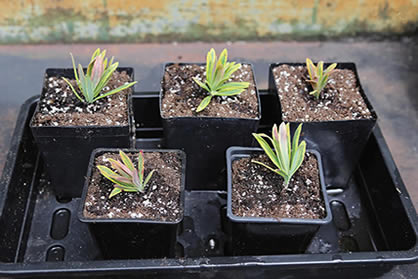
This includes popular varieties like Euphorbia trigona, Euphorbia tirucalli (Pencil Cactus), Euphorbia tithymaloides, and Euphorbia milii (Crown of Thorns).
-
Use a sharp, sterilized knife or shears to cut a healthy stem 4–6 inches long.
-
Place the cutting in a dry, shaded area for 3 to 5 days to allow the cut to callous over.
-
Once the end is dry and sealed, plant the cutting in dry, well-draining cactus or succulent soil.
-
Wait about a week before watering, then water lightly and gradually increase as roots develop.
Keep the cutting in bright, indirect light while it roots. Within 2–4 weeks, you should see signs of new growth.
Method 2: Offsets and Division (Best for Clumping Varieties)
If your euphorbia produces pups or grows in dense clusters, you can divide the plant at the root level.
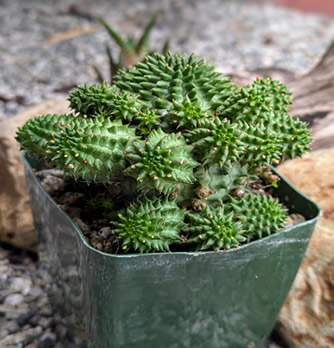
This works well for species like Euphorbia milii, Euphorbia mammillaris, and Euphorbia leuconeura.
-
Remove the mother plant from its pot and gently shake off excess soil.
-
Separate the plant into smaller sections, making sure each has some root and stem attached.
-
Allow any open wounds to callous for a day or two in a dry, shaded area.
-
Replant each division in succulent soil and water lightly after several days.
This method gives you instant new plants that are genetically identical to the parent.
Method 3: Seeds (For Rare or Non-Clonal Varieties)
Some euphorbias can be grown from seed, including Euphorbia obesa and Euphorbia leuconeura, which often self-seed indoors.

Seed propagation is slow but rewarding for patient growers.
-
Sow fresh seeds on top of moist cactus soil in a shallow container.
-
Press lightly into the surface without burying too deep.
-
Cover with a humidity dome or clear lid and place in bright, indirect light.
-
Keep the soil lightly moist until germination, which may take 2–4 weeks or more.
Once seedlings are large enough to handle, pot them individually in small containers.
Can You Propagate Euphorbia in Water?
In general, euphorbia is not suited to water propagation.
Their milky sap and succulent stems are prone to rot when submerged in water.
Instead, allow cuttings to callous and root in dry soil, which mimics their natural environment.
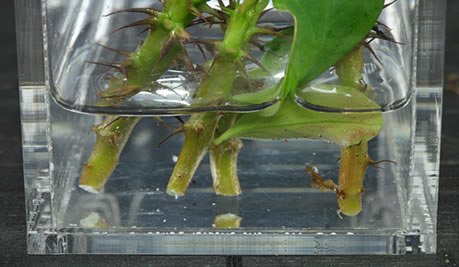
If you do experiment with water rooting (only for soft-stem types like E. tithymaloides), change the water frequently and keep the cutting just above the waterline—not submerged.
Adding a drop or two of a diluted succulent-safe fertilizer (e.g. 5-10-5 like this one, one-tenth strength) may help promote root development, but soil is always the safer option.
Outdoor Euphorbia Propagation
In warm climates (Zones 9–11), euphorbias can be propagated outdoors in containers or garden beds.
-
Take cuttings in spring or summer and allow them to callous in a shaded spot.
-
Plant them in sandy, well-draining soil, and hold off on watering for at least a week.
-
Keep new cuttings out of direct sun until established, then slowly acclimate them to brighter conditions.
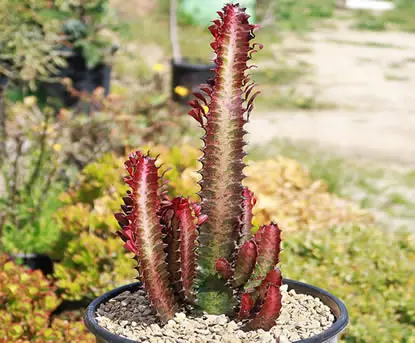
Avoid propagating during rainy seasons or in humid climates where rot is more likely.
Easiest Euphorbias to Propagate
These are some of the easiest and most rewarding Euphorbia types to propagate:
-
Euphorbia trigona (African Milk Tree) – tall, columnar and roots easily from cuttings
-
Euphorbia tirucalli (Pencil Cactus) – branching and fast-growing with minimal effort
-
Euphorbia milii (Crown of Thorns) – propagates well from stem cuttings and offsets
-
Euphorbia tithymaloides (Devil’s Backbone) – easy to root from sections of its zigzagging stem
-
Euphorbia leuconeura (Madagascar Jewel) – often self-seeds, but can also be divided
-
Euphorbia mammillaris – can be divided or grown from offsets
-
Euphorbia lactea (and ‘White Ghost’) – can be propagated from cuttings but often used in grafting
-
Euphorbia francoisii – propagated by cuttings but may take longer to root
-
Euphorbia obesa – typically grown from seed
Final Thoughts
Propagating euphorbia is one of the most rewarding ways to expand your succulent collection.
Whether you’re trimming back an overgrown trigona, dividing a clumping milii, or starting a rare type from seed, this genus offers endless opportunities to grow and share.
Just remember to protect your skin, keep the cuttings dry while they callous, and be patient—new euphorbias are worth the wait.
Once your new plants start to mature be sure you follow the guidelines set out in our article Euphorbia Plant Care: Growing These Sculptural Stunners Indoors and Out.

